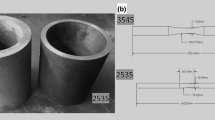Conclusions
The fatigue strength of copper alloys in different conditions after heat treatment indicates that Fe−Ni alloys and Al−Fe−Ni bronze have a low sensitivity to stress concentrations, which remains almost constant with increases in hardness and strength. The high notch sensitivity of the alloys in the cold-drawn condition is due to the negligible capacity for hardening by plastic deformation.
Annealing lowers the fatigue strength of smooth samples, but has a positive effect on the fatigue strength of notched samples.
Similar content being viewed by others

Literature cited
M. Ya. Shashin, in: Strength Tests of Machine Parts [in Russian], Mashgiz (1960).
Additional information
Leningrad Karablestroitel'nyi Institut. Translated from Metallovedenie i Termicheskaya Obrabotka Metallov, No. 12, pp. 64–66, December, 1969.
Rights and permissions
About this article
Cite this article
Meleshchenko, L.A., Shashin, M.Y. Susceptibility of Cu−Fe−Ni alloys to stress concentrations under alternating loads. Met Sci Heat Treat 11, 995–997 (1969). https://doi.org/10.1007/BF00654945
Issue Date:
DOI: https://doi.org/10.1007/BF00654945



